Delhi is a city of hearted people. In Delhi there are different tourist attractions and here are 12 best places to visit when you are in Delhi.
12 best places to visit in Delhi
Delhi, the national capital city of India, is a treasure of historical, cultural, and modern attractions that captivate tourists from around the world. Steeped in history, Old Delhi boasts landmarks such as the Red Fort, Jama Masjid, and Chandni Chowk, offering a glimpse into the city’s rich Mughal past. In contrast, New Delhi showcases architectural marvels like India Gate, Humayun’s Tomb, and the Lotus Temple, reflecting a blend of colonial and contemporary influences.
The city is a paradise for art and history enthusiasts with its numerous museums and galleries, including the National Museum and the National Gallery of Modern Art. Delhi also houses UNESCO World Heritage Sites like Qutub Minar and the archaeological site of Mehrauli. For shopping enthusiasts, markets like Sarojini Nagar and Dilli Haat offer a delightful array of traditional crafts, textiles, and street food. Additionally, Delhi’s diverse culinary scene is a gastronomic adventure, from street food stalls serving spicy chaat to upscale restaurants offering a fusion of flavours.
Delhi’s dynamic energy, liken with its ancient charm, makes it an enticing destination for travellers seeking a blend of history, culture, and contemporary experiences.
Here is the 12 best places in Delhi to visit:
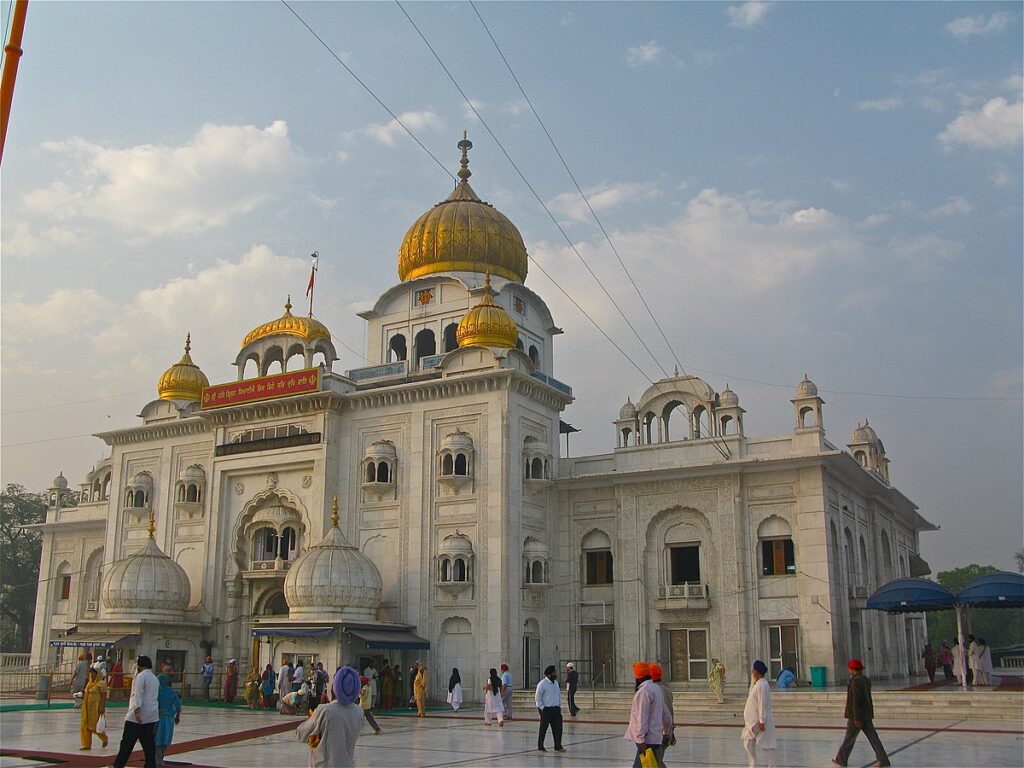
Gurdwara Sri Bangla Sahib, situated in the heart of Delhi, holds a sacred history rooted in the visit of Sri Guru Harkrishan Ji. The journey began at the beckoning of Mughal King Aurangzeb and the persuasion of Mirza Raja Jai Singh of Amber. Responding to Raja Jai Singh’s invitation to the site, originally his own, Guru Sahib’s spiritual presence was put to the test by the Raja’s wife, who disguised herself as a maid servant among the attendants. At the tender age of 8, Guru Sahib identified her and sat in her lap, validating the spiritual powers of Sri Guru Nanak Dev Ji and his true disciples. During those challenging times, Delhi was grappling with a smallpox epidemic. Touched by compassion, Guru Sahib, at the age of 8, dipped his holy feet in water and poured the sacred charan amrit into a small chaubacha (tank). Miraculously, those who took water from the tank found relief from the disease, saving the people of Delhi from the epidemic. Today, this divine water continues to draw devotees from far and wide, who come with faith and devotion to experience the healing power of a dip in the holy water, seeking solace from their suffering.
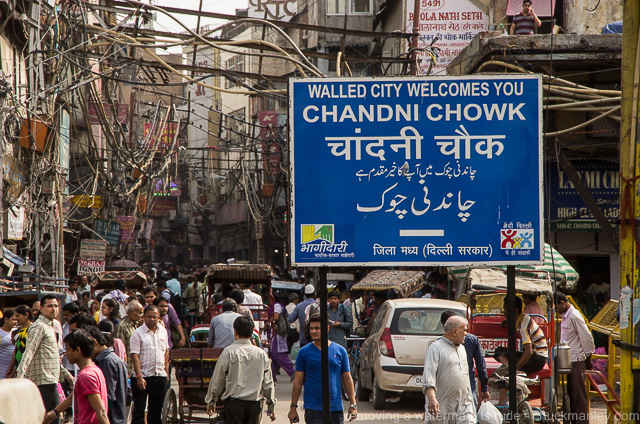
Step into the heart of Old Delhi and immerse yourself in the vibrant tapestry of Chandni Chowk, a bustling marketplace that weaves together centuries of history, culture, and commerce. Dating back to the 17th century, this iconic area, once the grand boulevard of Shah Jahan’s Delhi, remains a testament to the city’s rich past. The narrow lanes of Chandni Chowk unveil a treasure trove of historical landmarks. From the imposing Red Fort to the majestic Jama Masjid and the intricately designed Fatehpuri Mosque, every step echoes with tales of emperors and dynasties. For the shopper, Chandni Chowk is a paradise. The bustling bazaars host a kaleidoscope of goods, from traditional textiles and jewellery to aromatic spices and mouth watering street food. Don’t miss the vibrant and bustling markets like Kinari Bazaar and Dariba Kalan, where centuries-old craftsmanship meets contemporary tastes.
For tourists seeking an authentic slice of Delhi’s soul, Chandni Chowk stands as a living testament to the city’s glorious past and vibrant present. Step into this kaleidoscopic realm, where every corner tells a story, and every experience leaves an indelible mark.
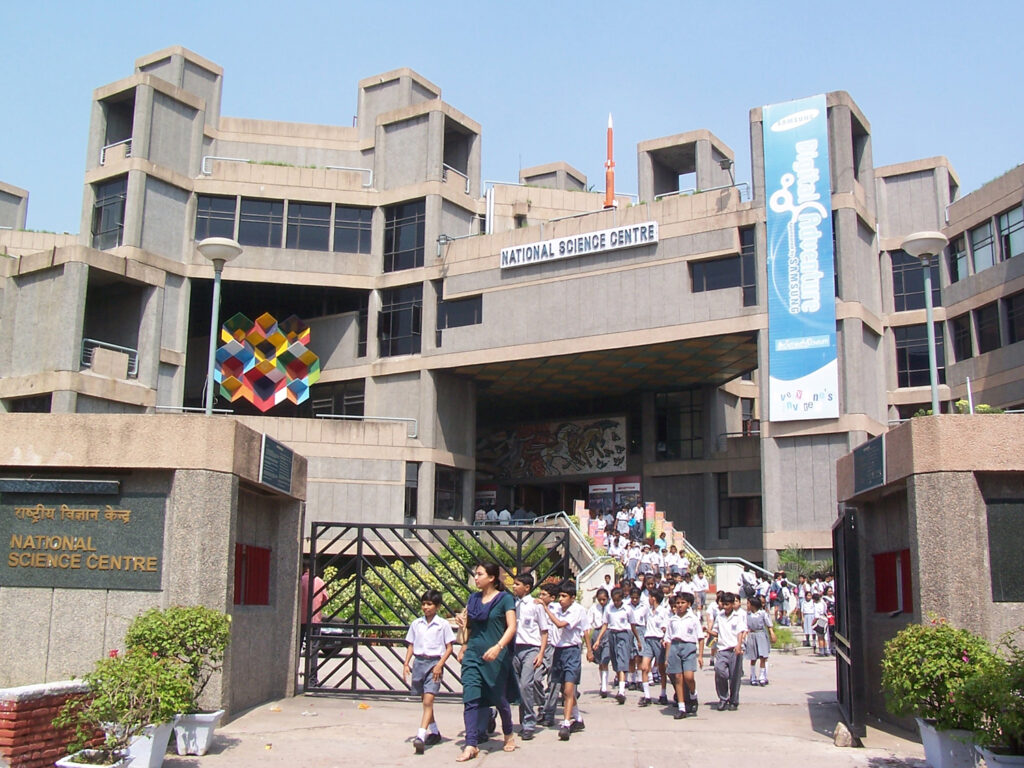
The National Science Centre in Delhi isn’t just a place—it’s a dream castle for everyone who walks through its doors. As one of the largest Science Centres in Asia, it’s a modern architectural marvel situated near the bustling Pragati Maidan Complex, the heart of India’s commercial exhibition hub. This iconic structure, often dubbed a “Dream Castle for One and All,” sees over half a million visitors annually. Among them are Nobel Laureates, distinguished scientists, technocrats, astronauts, and luminaries from various fields who find inspiration within its walls. The Centre’s mission goes beyond just being a showcase; it aims to engage, educate, and entertain through thematic exhibitions, interactive activities, and outreach programs. Opened on January 9, 1992, by the then Hon’ble Prime Minister of India, Shri P V Narsimha Rao, the National Science Centre is part of the National Council of Science Museums (NCSM). NCSM oversees 27 Science Centres and Science Cities, all working towards making science accessible and exciting. Funded and governed by the Ministry of Culture, Government of India, the National Science Centre stands as a beacon of knowledge, exploration, and wonder.
4) RAJGHAT

Situated along the banks of the Yamuna River in the heart of Delhi, Raj Ghat stands as a national heritage, inviting tourists to pause and reflect. This sacred memorial, dedicated to Mahatma Gandhi, the father of the nation. Surrounded by green lawns and marked by a simple black marble platform, Raj Ghat symbolizes the final resting place of the freedom leader. The eternal flame at the site pays homage to his unwavering commitment to truth and non-violence. As visitors tread softly on the path, they find themselves in the midst of Mahatma Gandhi’s teachings and legacy. The serene ambiance makes Raj Ghat a vital escape from the busy city, offering a moment of quiet reverence amidst the trees and floral beauty. For tourists seeking a place of historical significance and spiritual solace, Raj Ghat beckons with its simplicity and profound symbolism. It’s not just a memorial; it’s a tribute to the ideals that shaped a nation and an invitation to connect with the soul of India’s independence movement.
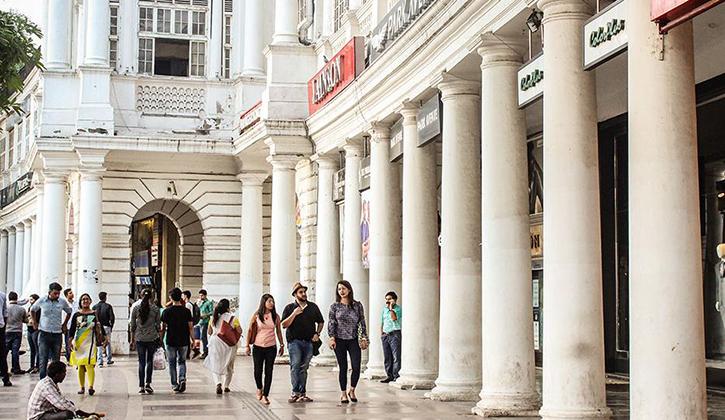
This expansive circular market was a pioneering concept in India, thought to bring luck to both shoppers and shopkeepers. Divided into two circles, the Inner Circle (Blocks A to F) is home to renowned brands like Adidas Originals, Allen Solly, Bentley, Gas, Nike, and Wills Lifestyle. Noteworthy stores like Mohanlal Sons cater to diverse occasions with ready-made and tailored attire, while Ganga Ram & Sons in the Regal Building offers premium wool and Cashmere suiting. Venturing into the Outer Circle (Blocks G to P), shoppers can explore showrooms like Digjam, Lacoste, Omega, and TAG Heuer. Ganganoly Bros., a generational favorite, specializes in clocks and watches, while Ivory Mart Jewellers in the InterContinental Hotel presents traditional pieces adorned with hand-picked diamonds. The small yet exquisite range of handicrafts at Ivory Mart is also worth a look. This market, conceived as a lucky horseshoe by the British, continues to weave a tapestry of high-end shopping experiences, offering a diverse array of brands and curated pieces for every taste and occasion.

Spread over 4 square kilometres, the Okhla Bird Sanctuary (OBS) welcomes visitors at the entrance of NOIDA in the Gautam Budh Nagar district of Uttar Pradesh. Located at the point where the Yamuna River transitions from Delhi to Uttar Pradesh, OBS stands out as one of the 15 bird sanctuaries in the state. This sanctuary is a haven for bird species accustomed to thorny scrub, grassland, and wetland habitats, thanks to its unique location. The wetland itself owes its existence to the Okhla Barrage. Recognizing its ecological significance, the Uttar Pradesh Government designated it as a sanctuary in 1990. Today, it proudly holds a place among the 466 Important Bird Areas (IBAs) in India. A visit to OBS promises not just a glimpse of diverse birdlife but also an immersion into the unique ecosystem shaped by the Yamuna’s course and the sanctuary’s protective embrace.
7) NATIONAL ZOOLOGICAL PARK

Step into the National Zoological Park, where a diverse array of birds, reptiles, and mammals thrive in environments carefully crafted to mirror their natural habitats. This isn’t just a haven for wildlife; it’s a place where endangered species find refuge and even flourish through carefully managed breeding programs. As you wander through the park, you’ll encounter captivating residents like the majestic White Tiger, the imposing Gaur, the sleek Jaguar, the colossal Rhinoceros, the gentle Elephants, the elegant Brow-antlered Deer (Sangai), the lively Lion-tailed Macaque, and a host of migratory birds that grace the park during winters. Each visit is a chance to connect with these remarkable creatures, appreciate their beauty, and learn about the critical conservation efforts taking place within the zoo’s boundaries.

Akshardham,” translating to the divine abode of God, is not just a place; it’s an eternal sanctuary of devotion, purity, and peace. Within its walls, timeless Hindu spiritual messages, vibrant devotional traditions, and ancient architecture come together in a symphony of art and spirituality. This Mandir is a humble homage to Bhagwan Swaminarayan and other revered figures in Hinduism, constructed with traditional styling and inaugurated on November 6, 2005, with the blessings of HH Pramukh Swami Maharaj. Crafted by the skilled hands of artisans and volunteers, the complex stands as a testament to unity and dedication. Over 300 million volunteer hours, contributed by more than 8,000 volunteers from around the globe, went into the making of this marvel. The Mandir itself, constructed from intricately carved sandstone and marble, is a visual feast.
9) LOTUS TEMPLE
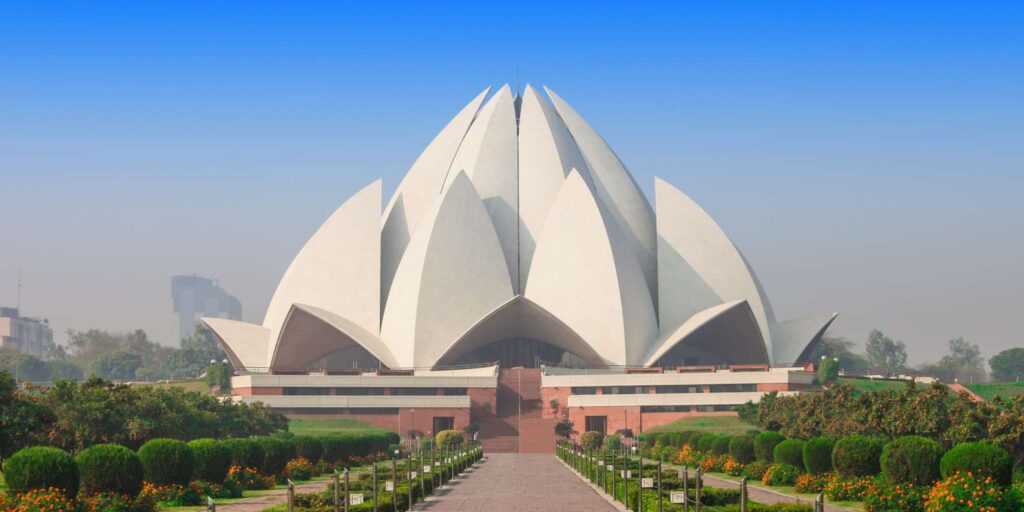
Located east of Nehru Place, the Lotus Temple stands as a stunning architectural marvel, shaped like a delicate lotus flower. As the seventh and final Bahai’s temple globally, its completion in 1986 marked the culmination of a sacred journey. Surrounded by lush green gardens, this pure white marble structure is not just a temple; it’s a harmonious blend of spirituality and nature. Architect Furiburz Sabha, in his wisdom, chose the lotus as a symbol transcending Hinduism, Buddhism, Jainism, and Islam. This intentional inclusivity means people of any faith are welcome to visit, offering their prayers or finding moments of quiet meditation within its serene walls. Surrounding the blooming petals, nine pools of water come to life in natural light, creating a mesmerizing ambiance. The temple truly comes alive at dusk when it’s bathed in gentle floodlights, presenting a spectacle that leaves a lasting impression on every visitor fortunate enough to witness it. The Lotus Temple is more than an architectural wonder; it’s a place where diverse faiths come together in a celebration of unity and tranquillity.
10) RED FORT
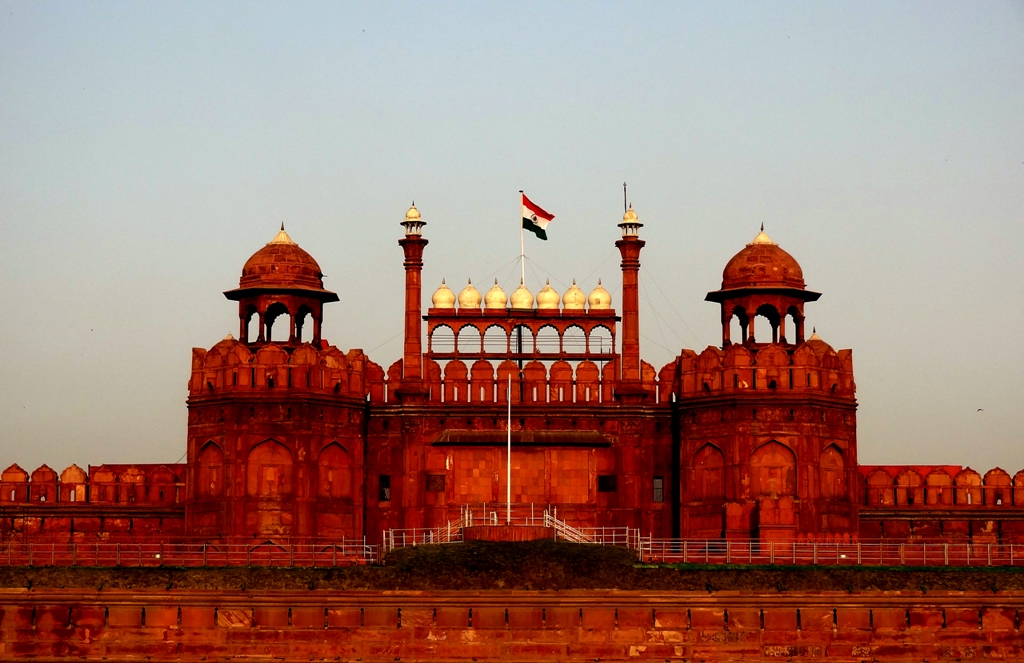
Nestled in the heart of Delhi, the grand Red Fort is more than just a structure; it’s a living testament to the Mughal dynasty’s architectural brilliance. This UNESCO World Heritage Site, affectionately known as Qila-e-Mubaraq, is a captivating ensemble of palaces, pavilions, and mosques, all crafted from the finest red sandstone. Commissioned by the Mughal emperor Shah Jahan, the Red Fort served as the opulent palace fort for his capital, Shahjahanabad. Its fame extends beyond its striking beauty to the massive enclosing walls that have witnessed centuries of history. The fort’s construction, a monumental feat, unfolded over a decade, from 1638 to 1648, leaving behind a legacy that continues to awe and inspire.
11) QUTAB MINAR
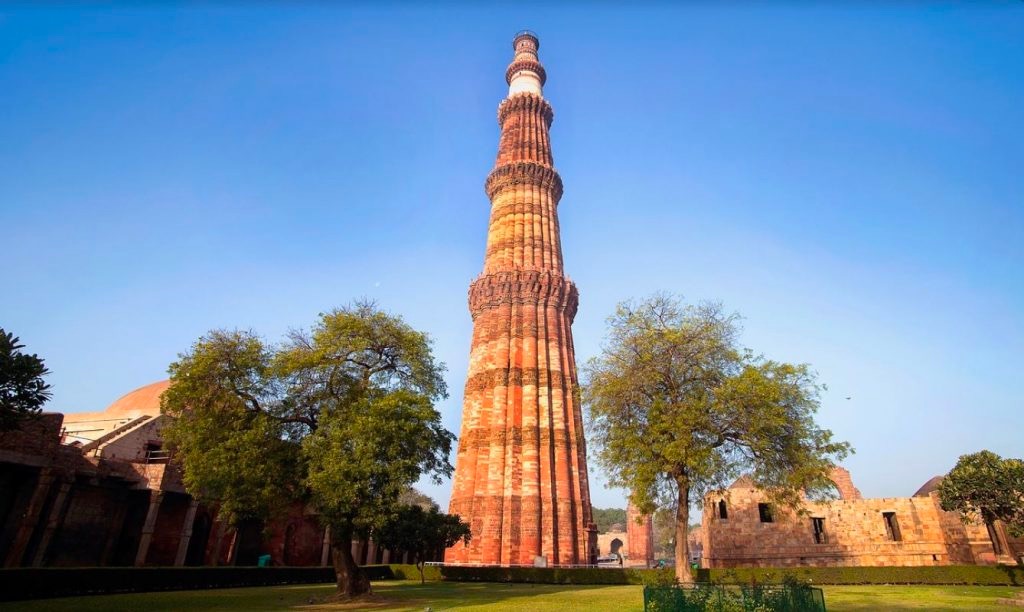
Standing proudly a few kilometers south of Delhi, the Qutb Minar, an architectural gem from the early 13th century, is a breathtaking testament to craftsmanship. This red sandstone tower reaches a height of 72.5 meters, gracefully tapering from 2.75 meters in diameter at its peak to 14.32 meters at its base, adorned with a mesmerizing mix of angular and rounded flutings. Within its archaeological embrace, you’ll discover more than just the towering minaret. Noteworthy structures, like the magnificent Alai-Darwaza Gate, a masterpiece of Indo-Muslim art erected in 1311, and two mosques, including the Quwwatu’l-Islam, the oldest in northern India, await exploration. The latter, crafted from materials repurposed from around 20 Brahman temples, weaves a rich tapestry of history and cultural fusion. The Qutb Minar and its surroundings are more than mere relics; they are an immersive journey into the marvels of ancient architecture and the stories etched in the stones of time.
12) HUMAYUN TOMB

Nestled near the intersection of Mathura Road and Lodhi Road, this enchanting garden tomb stands as a landmark in Mughal architecture, marking its debut in India. Constructed in 1565 A.D., a poignant nine years after Humayun’s passing, it was a labour of love by his senior widow, Bega Begam. Within the walled sanctuary, the garden unfolds with its serene squares (Charbagh), crisscrossed by pathways and water channels, leading the way to a meticulously designed mausoleum topped by a graceful double dome. The enclosure holds more than just architectural wonders; it cradles the final resting places of several Mughal rulers. Notably, in 1857 A.D., Lieutenant Hudson captured the last Mughal emperor, Bahadur Shah II, marking a chapter in history that echoes within these timeless walls. This garden tomb is more than a structure; it’s a living narrative, blending nature, architecture.

